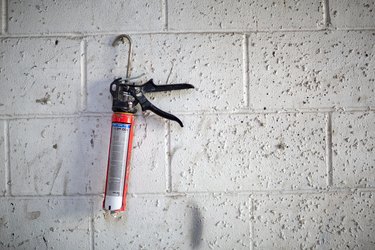
Caulk is used around the home to seal cracks and joints. Butyl caulk is a type of caulking that is both waterproof and weather-resistant, which makes it the perfect option for outdoor projects, such as sealing gutters and around chimneys.
What Is Butyl Caulk?
Video of the Day
Butyl caulk contains butyl rubber. It is used to seal gaps and is effective within minutes of application. Once cured, the caulk is both water-resistant and elastic which makes it extremely effective for use outdoors. In addition, it can bind effectively to a variety of surfaces including concrete, glass, masonry surfaces, metal and wood, which makes it an extremely versatile caulk.
Video of the Day
You can use butyl caulking to seal joints on the roof and chimney, in basements and outdoor foundations. You can even use it for gaps in aluminum siding.
How to Use Butyl Caulk
Butyl caulk can seal a variety of surfaces, but you still need to prepare the surface for best results. Make sure it is clean and dry. Clean any loose mortar, dust and old finishes using any appropriate method such as power washing or scrubbing with a wire brush. If there is any mold or mildew on the surface, remove it fully with a diluted bleach solution. Make sure the temperature is at least 40 degrees Fahrenheit and less than 120 degrees when applying butyl caulk.
Next, warm the caulk, as it is very difficult to apply when it is cold. You can do this by soaking the tube in warm water for about 20 minutes. This step may not be necessary in warmer weather. Then, cut the tip of the tube at a 45-degree angle. Load the tube of caulk in the caulk gun and squeeze the caulk gun trigger to start the flow of caulk. It is a good idea to test the caulk to make sure the flow is sufficient to seal the joint.
When you are ready, squeeze the trigger to apply the caulk at about a 30-degree angle to the joint. Immediately smooth out the caulk with a caulk tool. Be sure to check the product label and follow all instructions as there may be some differences between brands.
Butyl Caulk Safety Considerations
Butyl caulk can be hazardous when applied incorrectly. It has been classified as a carcinogen and may cause germ cell mutation. In addition, it can cause eye damage and is toxic when ingested or inhaled.
If the product is ingested, be sure to contact poison control or your doctor right away. If you get the caulk in your eyes, rinse them with clean water and remove your contact lenses. If symptoms from skin or eye contact continue, even after rinsing, seek medical attention.
When applying the caulk, wear protective clothing, including long sleeves and gloves. Make sure you also have a face mask or eye protection. Make sure the area is well-ventilated and move outdoors to fresh air immediately if it is inhaled. Use a respirator if you must use the caulk in a poorly ventilated area. Change your clothes and wash your hands thoroughly when you are finished.